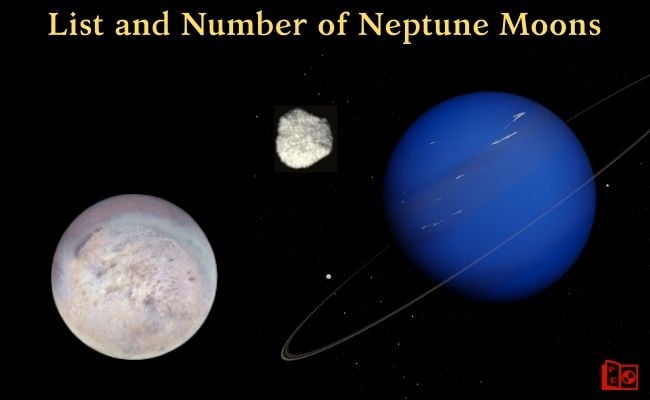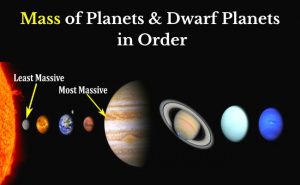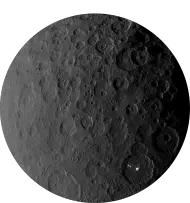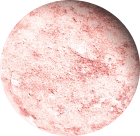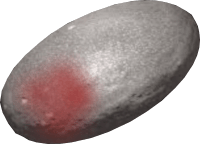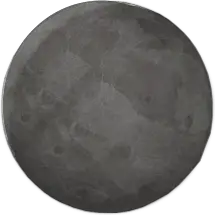Neptune is the farthest planet of our solar system and it has 14 known moons. In the 14 Neptune Moons, Triton is the largest moon of Neptune.
The first discovered Neptune moon was ‘Triton’ (in 1846), whereas in 2013 astronomer ‘Mark R. Showalter’ discovered the latest Moon of Neptune ‘Hippocamp’. He found the Hippocamp moon while examining the old photographs of the Hubble Space Telescope (HST).
| Must Read – Total Number of Moons in Solar System |
Discovery of Neptune Moons
Neptune planet was discovered by a German astronomer “Johann Galle” on 23 Sep 1846. Just 17 days after the discovery of this planet, on 10 Sep 1846, the first Neptune Moon ‘Triton’ was discovered by English astronomer William Lassell. Then there’s no moon of Neptune found till a century.
A Dutch astronomer Gerard P. Kuiper’ found the second discovered Neptune Moon “Nereid” in 1949. Whereas astronomer ‘Harold J. Reitsema’ and his team found the 3rd discovered Neptune moon ‘Larissa’ in 1981.
When ‘Voyager 2’ spacecraft flew by Neptune in 1989, then it found 5 inner moons of Neptune (Naiad, Thalassa, Despina, Galatea, and Proteus).
The 5 outer moons of Neptune (Halimede, Sao, Psamathe, Laomedeia, and Neso) get discovered with help of large ground-based telescopes between 2002-2003.
While the 14th or the new moon of Neptune ‘Hippocamp’ was discovered on 01 July 2013.
Facts and Information about Neptune Moons
# Here in this article, we have added about all 14 Neptune moons with their names and a list of other information.
# The largest moon of Neptune is ‘Triton’ with a diameter of around 2706 kilometers (1681 miles).
# The size of Triton according to the diameter is 78% of the earth’s moon. As the diameter of the earth’s moon is almost 3474 km.
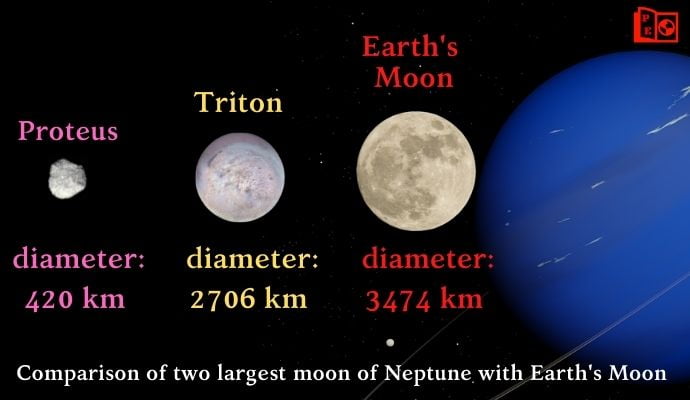
# Triton is the seventh-largest moon of our solar system and the only large moon that have a retrograde orbit.
# One of the facts about Neptune moons is, the second-largest moon of Neptune ‘Proteus’ has only 0.25% mass of Triton. The mass of Proteus is around 44 × 1018 kg, whereas the mass of Triton is 21 × 1021 kg.
# Neptune has two groups of satellites; 1. Regular satellites, 2. Irregular satellites.
# The regular satellites of Neptune are near to the planet and have prograde orbits. In order of increasing distance, the list of 7 regular Neptune moons is- Naiad, Thalassa, Despina, Galatea, Larissa, Hippocamp, and Proteus.
# Whereas the irregular satellites are farther from Neptune and have both types of orbits, prograde and retrograde. In order of increasing distance from Neptune, the 7 irregular satellites are- Triton, Nereid, Halimede, Sao, Laomedeia, Psamathe, and Neso.
# Psamathe and Neso are so far away that they have the largest orbit of any natural moon in our solar system discovered so far.
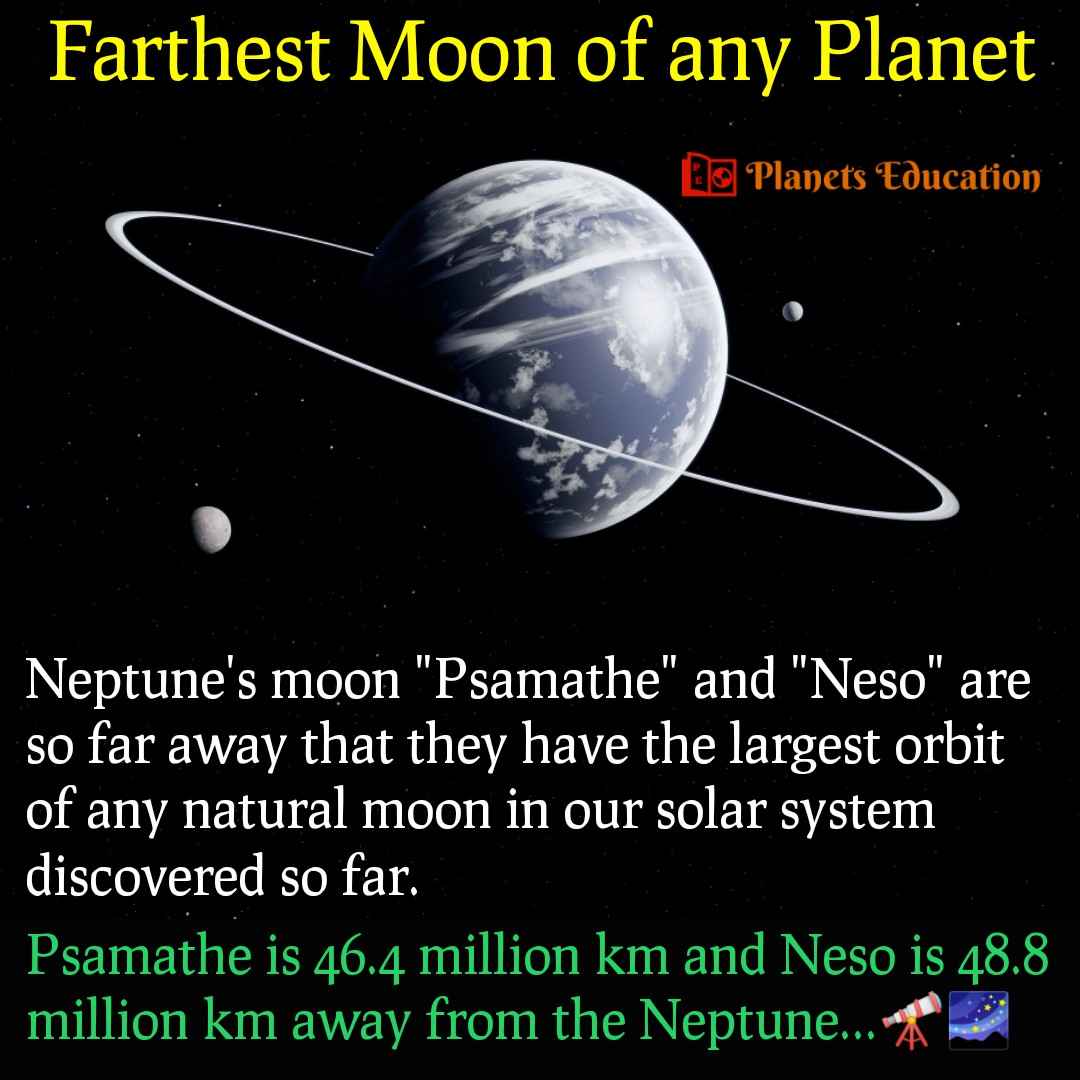
# Moon Triton is so massive that it contains more than 99% mass of all Neptunian moons.
# Scientists believe that ‘Halimede Moon’ could be a part of ‘Nereid Moon’ because both appear in the same grey color. They may have collided in the past.
Neptune Number of Moons: Name and List
Here you can find Neptune number of moons with their names. These mentioned natural satellites of Neptune planet are in order of increasing distance from Neptune.
| Neptune Moons | Distance | Diameter |
| Naiad | 48224 km | 60.5 km |
| Thalassa | 50073 km | 81.5 km |
| Despina | 52525 km | 157 km |
| Galatea | 61955 km | 175 km |
| Larissa | 73550 km | 195 km |
| Hippocamp | 105285 km | 35 km |
| Proteus | 117645 km | 420 km |
| Triton | 354760 km | 2706 km |
| Nereid | 5.5 million km | 360 km |
| Halimede | 16.6 million km | 62 km |
| Sao | 22.3 million km | 44 km |
| Laomedeia | 23.5 million km | 42 km |
| Psamathe | 46.4 million km | 40 km |
| Neso | 48.8 million km | 60 km |
So this was the list of fourteen Neptune moons. As Neptune is the farthest planet of our solar system, it becomes difficult to detect its moon. Scientists still searching more, hope the Neptune number of moons will increase soon.
Related Articles:-
- 5 Best Solar System Backpacks in 2024
- Mass of Planets in Order from Lightest to Heaviest
- Star Projector {2024}: Star Night Light Projector
